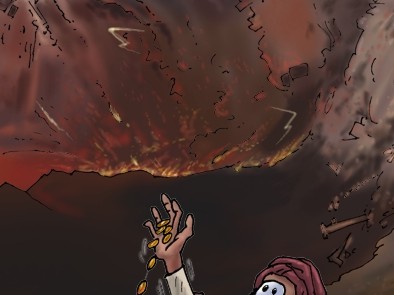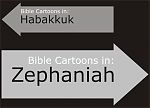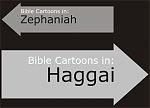Bible Cartoon: Zephaniah 01 - Day of God’s Judgment - Scene 03 - Great Day near
Click on Add to cart button below shopping cart.
Purchased Bible Cartoons do not have watermarks. Links to Cartoons provided on email once purchase is completed.Bible Book: Zephaniah
Bible Book Code: 3600101401
Scene no: 1 of 1
Bible Reference & Cartoon Description
Zephaniah 1:14-18 (ANIV)
[The great day of the Lord]
14 “The great day of the Lord is near—
near and coming quickly.
Listen! The cry on the day of the Lord will be bitter,
the shouting of the warrior there.
15 That day will be a day of wrath,
a day of distress and anguish,
a day of trouble and ruin,
a day of darkness and gloom,
a day of clouds and blackness,
16 a day of trumpet and battle cry
against the fortified cities
and against the corner towers.
17 I will bring distress on the people
and they will walk like blind men,
because they have sinned against the Lord.
Their blood will be poured out like dust
and their entrails like filth.
18 Neither their silver nor their gold
will be able to save them
on the day of the Lord’s wrath.
In the fire of his jealousy
the whole world will be consumed,
for he will make a sudden end
of all who live in the earth.”
DRAWING NOTES:
TIME OF DAY:
Not specified in the Bible text – this being a prophecy.
LIGHTING NOTES:
The sun (blood-red in the centre of the scene) & lightning provide the dim illumination for this picture.
CHARACTERS PRESENT:
Various idolotrous, wicked Hebrew people, falling into the abyss.
RESEARCH/ADDITIONAL NOTES:
For many years I have admired John Martin’s large & dramatic oil paintings. My picture is a little homage to one of his most famous paintings, “The Great Day of His Wrath”. I discuss John Martin’s work & my reaction to it, further down this page.
I started this scene by creating a pen & ink drawing of the major elements, & proceeded to colour up, using John Martin’s painting as a reference for colour & tonality. My version retains the black ink keyline (outline) around the major elements of the picture which characterises my work & is a deliberate design choice. Obviously John Martin’s painting doesn’t use that “cartoony” feature; he was a much subtler & greater artist than I am!
Here’s the scene without the figures, & so is more like John Martin’s original painting:

Background of Zephaniah 01 – Day of God’s Judgment – Scene 03 – Great Day near
Click on the colour bar below to view/buy this Background:
Background of Zephaniah 01 – Day of God’s Judgment – Scene 03 – Great Day near
Below are some close-up details of the picture:

Zephaniah 01 – Scene 03 – Great Day near – PARTIAL 01 100 dpi col (Detail of background fire in earthquake.)

Zephaniah 01 – Scene 03 – Great Day near – PARTIAL 02 100 dpi col (Detail of lightning bolt on city.)

Zephaniah 01 – Scene 03 – Great Day near – PARTIAL 03 100 dpi col (Detail of falling figures.)
Another major difference between our works is the inclusion in my own of the large foreground figures. In Martin’s own work the figures are very small & unobtrusive, whereas mine are large & bold! I am principally interested in creating a Bible cartoon, rather than a landscape picture, so the inclusion of large figures is a deliberate design decision as well. I have deliberately used colours for skin tones & clothing from the background, so that even though the figures are large, they won’t unbalance the composition & protrude too much into the viewer’s focus. If I’d used contrasting colours (blues & greens) then they would stuck out like a sore thumb!
I estimate it might have taken John Martin a year to complete his work. According to the Tate Britain the dates for the complete triptych are 1851–3, which would equate to about 1 year for each of the 3 paintings. I have taken 2 days to produce this scene on my computer – how amazing modern technology is!
The more I looked at “The Great Day of His Wrath”, s I reproduced the work, the more I found to see: tiny details & passages of colour that I hadn’t noticed before – no wonder it took so long to paint! I took the decision to greatly simplify my version, or else it might have taken me a year to complete as well!
I am pleased with the version I have been able to produce, & a wonderful benefit of looking so closely at Martin’s original (in order to reproduce it) is an increased awareness of the breathtaking drama & subtlety of his work.
Historical & Biblical background & context of this scene.
Zephaniah 1:1 informs us that he was a descendant of Judah’s King Hezekiah. “Prophet of universal judgment” is a name that has been associated with Zephaniah. He was given a prophetic vision that looked far ahead into the future, and describes a day when God will finally judge all, & all will demonstrate God’s sovereignty. Not only was Zephaniah’s “eye” on the far future, his concern was for the immediate state of his nation’s sinfulness, which would lead them into slavery & exile in their own very near future.
Verse 14 (see above Bible quotation) “The great day of the Lord is near— “ is a repeat of verse 7 & a literary return to that earlier stated theme. As Matthew Henry (the Bible Commentator) said, “Zephaniah intended not to frighten them [the Hebrew people] out of their wits, but to frighten them out of their sins.” – Good point, & just as valid to us in the 21st Century as it was to the people in Zephaniah’s day!
Israel & Judah ware spiritually complacent nations at the time of Zephaniah – dangerously close to all the judgments described by that prophet. Zephaniah wrote shortly after 622 b.c., which was the year of (good) king Josiah’s partial revival, a little “high point” of Hebrew return to the worship of the Lord, amidst years of their idolatrous worship of other nation’s deities.
In 605 b.c., only 17 years after Zephaniah’s prophecy was delivered to the Hebrew people, Judah (now under the reign of king Jehoiakim) became a vassal of the Babylonians. At this time many of Judah’s best young men were deported to Babylon.
In 597 b.c. Nebuchadnezzar (king of Babylon) besieged Jerusalem (then ruled by Jehoiakim’s equally wicked successor, Jehoiachin) & about 10,000 Hebrew people were deported to Babylon.
in the summer of 586 b.c, Under Zedekiah, Jerusalem came under a long siege by Nebuchadnezzar and was finally destroyed.
John Martin (1789–1854)
English Romantic painter and mezzotint engraver, born in Northumberland. Very popular in his own lifetime for dramatic scenes of cataclysmic (often Biblical) events crowded with tiny figures placed in vast architectural or landscape settings.
John Martin’s “The Great Day of His Wrath” is an oil on canvas painting from 1853. Measuring 77.36 × 136.6 inches (6.44 × 11.3 feet) or 1965 × 3470 mm (1.9 × 3.47 metres) it is a stunning & thought-provoking scene.
“The Great Day of His Wrath” shows an entire city being torn up and thrown into the abyss. Along with 2 other paintings (“The Last Judgement” and “The Plains of Heaven”) it forms a vast triptych, the Judgement Series.
Inspired by the Book of Revelation (see quote below [1]), the paintings were originally to be “read” (from left to right) as follows: “The Plains of Heaven” (depicting the elect/chosen), “The Last Judgement” (the central painting, showing the Lord God, Satan’s downfall, & 2 groups of people, the elect/chosen on the left & the condemned on the right), with “The Great Day of His Wrath” on the right of the other two paintings, showing the condemned falling into the abyss of Hell.
In “The Great Day of His Wrath”, Martin depicted the damned falling into the abyss, including richly dressed women, notably Salome daughter of Herodias, and the whore of Babylon, and also lawyers and clergymen, including a bishop and a pope. A railway train with carriages labelled “London” and “Paris” tumbles into the bottomless pit. The forces of Satan are being defeated, with the armies of Gog and Magog also falling into the abyss.
I have seen all 3 of these paintings whilst on an Art History field trip (1987-8), in the Tate Britain gallery, London. I stood before them for quite a while, admiring their complexity & drama, although, at the time, I didn’t know they should be viewed together as one vast triptych scene.
“A mezzotint engraver, he [John Martin] was keen to make prints of his paintings, as a ‘means which would enable the public to see my productions, and give me a chance of being remunerated for my labours’. The artist did not just view his prints as commercial reproductions, but as works of art in their own right. He involved himself in the production process at every stage, even inking his own plates, a job which was normally left to specialist printers.”
[Source: http://www.visual-arts-cork.com/famous-artists/john-martin.htm]
That comment of John Martin’s, about receiving remuneration for his labours, is one of the reasons I make Bible Cartoons available on this website… it appears I am in good company!
[1]
Revelation 6:12-14 – King James Version (KJV)
12 And I beheld when he [the Lamb of God] had opened the sixth seal, and, lo, there was a great earthquake; and the sun became black as sackcloth of hair, and the moon became as blood; 13 And the stars of heaven fell unto the earth, even as a fig tree casteth her untimely figs, when she is shaken of a mighty wind. 14 And the heaven departed as a scroll when it is rolled together; and every mountain and island were moved out of their places.
Zephaniah’s prophecy
Zephaniah’s prophecy has two major themes:
1) A bold declaration of God’s imminent wrath against the wicked (which calls for a serious call to repentance from the unfaithful in order to escape that judgement!)
2) The comforting words that even in His judgment against the wicked, God will not forget his covenant promise of mercy to all who revere Him (His chosen people) seen most clearly in chp 3:9-20.
It is interesting to note that Zephaniah starts & ends his book with a stern warning of doom. Chapter 1 begins with a pronouncement of God’s judgment on the earth (verses 2-3) and chapter 3 concludes with the same theme (verse 8).
Between these two messages of universal wrath, Zephaniah focuses his attention upon Judah and/or Jerusalem, also with two similar messages (chp 1:4-2:3 & chp 3:1-7.) In the centre of the book Zephaniah focuses once on the nations surrounding the Judah & Jerusalem (chp 2:4-15).
This literary device creates an interesting introversion pattern which can be viewed in the following manner:
1 Judgment on all the earth (1:2-3)
2 Judgment on Judah and Jerusalem (1:4-2:3)
3 Judgment on the surrounding nations (2:4-15)
2 Judgment on Jerusalem (3:1-7)
1 Judgment on all the earth (1:2-3)





